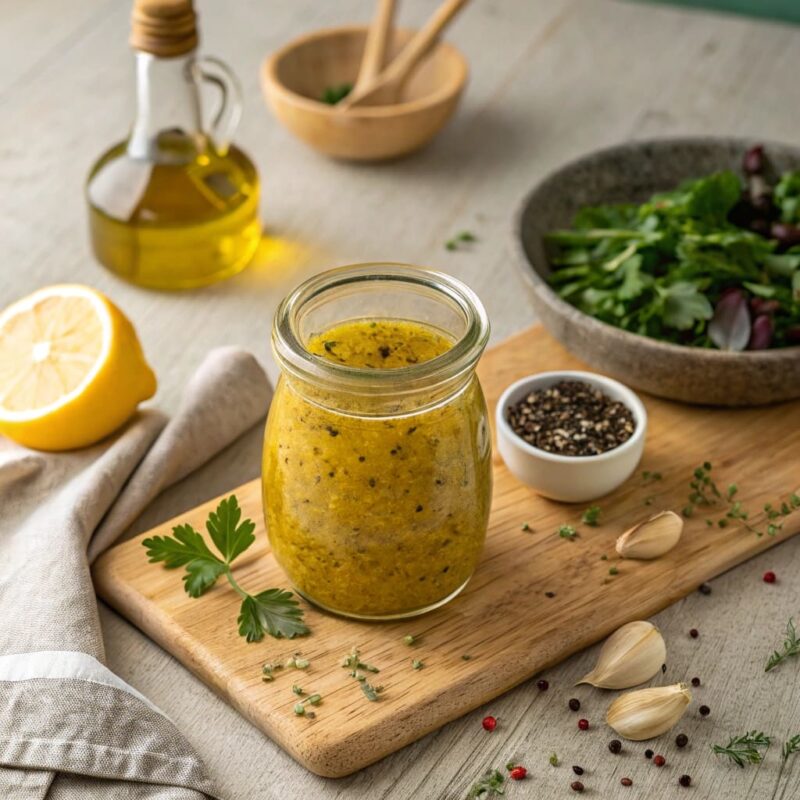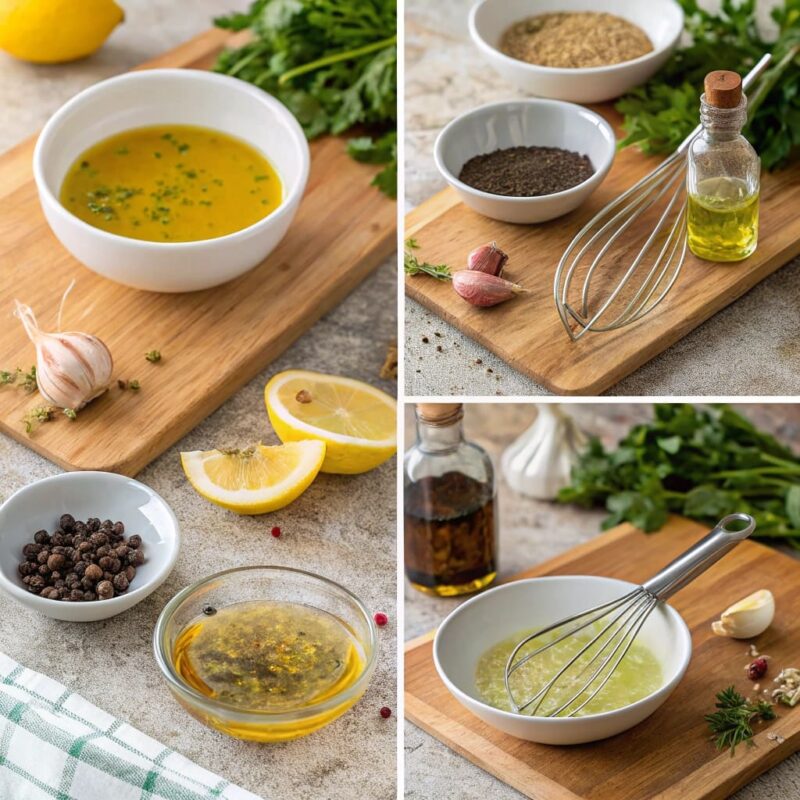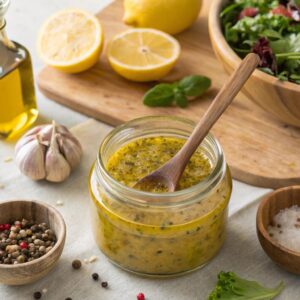
Mediterranean salad dressing embodies the essence of Mediterranean cuisine, celebrated worldwide for its vibrant flavors and health benefits. This culinary tradition stems from countries bordering the Mediterranean Sea, such as Greece, Italy, and Spain, where fresh, wholesome ingredients take center stage.
What makes Mediterranean salad dressings stand out? They strike a perfect balance between bold flavors and nutritional value. Packed with heart-healthy fats, zesty citrus, and aromatic herbs, these dressings are as nourishing as they are delicious. Their versatility is another advantage, effortlessly elevating salads, roasted vegetables, and even grilled proteins.
Unlike many commercial salad dressings loaded with preservatives and sugar, Mediterranean dressings rely on natural ingredients. This simple approach aligns with the Mediterranean diet—a globally recognized way of eating that promotes longevity and overall well-being. Ready to explore what makes these dressings so special? Let’s dive deeper into their key components.
Key Ingredients in Mediterranean Salad Dressing
Olive Oil: The Heart of Mediterranean Dressing
When it comes to Mediterranean salad dressing, olive oil is the star ingredient. Specifically, extra virgin olive oil (EVOO) is preferred for its robust flavor and exceptional health benefits. EVOO is rich in monounsaturated fats, which are known to support heart health by reducing bad cholesterol levels. It’s also packed with antioxidants like vitamin E and polyphenols, which help combat inflammation.
Why is olive oil a staple in Mediterranean cuisine? Its mild yet distinct flavor complements a variety of dishes without overpowering them. Plus, it creates the perfect base for emulsifying dressings, ensuring a smooth and creamy consistency. For the best results, opt for high-quality cold-pressed olive oil—its vibrant green hue and fruity aroma signal freshness and quality.
Learn more about the importance of olive oil in recipes like Mediterranean salmon for a full appreciation of its versatility.
Lemon Juice and Vinegar: Adding Zing
Acidity is key to achieving a balanced Mediterranean salad dressing, and lemon juice and vinegar deliver just that. Lemon juice, with its bright and tangy profile, enhances the freshness of the dressing while providing a dose of vitamin C.
Vinegar, on the other hand, offers a slightly different dimension. From red wine vinegar to apple cider vinegar, each type brings its unique flavor. Red wine vinegar is a classic choice, adding a bold, slightly sweet taste that pairs perfectly with olive oil. Apple cider vinegar, with its subtle tartness, is another popular option for a lighter dressing.
Herbs and Spices: The Mediterranean Flavor Palette
No Mediterranean salad dressing is complete without a generous sprinkle of herbs and spices. Fresh and dried herbs like oregano, parsley, and basil are staples, imparting earthy and aromatic notes.
Oregano, often referred to as the “pizza herb,” is a quintessential Mediterranean ingredient. Its bold flavor stands out in dressings, marinades, and more. Basil, on the other hand, adds a touch of sweetness, while parsley brings a bright, slightly peppery kick.
Spices such as black pepper, paprika, and sumac further enhance the flavor profile. For a hint of heat, crushed red pepper flakes are a great addition, perfect for those who enjoy a spicy kick.
Optional Add-Ins: Garlic, Honey, and Mustard
To customize your Mediterranean dressing, consider optional ingredients like garlic, honey, or mustard. Garlic adds depth and a savory undertone, while honey balances acidity with a touch of sweetness. Dijon mustard, often used as an emulsifier, ensures a silky consistency while introducing a tangy complexity.
These add-ins not only enhance flavor but also allow you to tailor the dressing to suit your taste preferences. Whether you prefer a sweet, tangy, or garlicky profile, there’s a variation to match your cravings.
How to Make Classic Mediterranean Salad Dressing

Crafting a traditional Mediterranean salad dressing at home is both simple and rewarding. Here’s a step-by-step recipe to get you started:
Ingredients:
- ½ cup extra virgin olive oil
- 3 tablespoons fresh lemon juice or red wine vinegar
- 1 teaspoon Dijon mustard
- 1 clove garlic, finely minced
- 1 teaspoon dried oregano
- Salt and freshly ground black pepper to taste
Instructions:
- In a small bowl or jar, combine the olive oil, lemon juice (or vinegar), Dijon mustard, and minced garlic.
- Add dried oregano, salt, and black pepper.
- Whisk or shake the mixture vigorously until it forms a smooth emulsion.
- Taste and adjust seasoning if needed.
Pro Tip: To achieve the perfect emulsion, use room-temperature ingredients and mix the dressing just before serving. Store leftovers in an airtight container in the fridge for up to a week, giving it a good shake before each use.
Variations of Mediterranean Salad Dressing
Greek Salad Dressing vs. Mediterranean Salad Dressing
While both Greek and Mediterranean salad dressings are rooted in the same culinary tradition, they have distinct flavor profiles and ingredient compositions. Greek salad dressing is a subset of Mediterranean dressings, often featuring stronger, bolder flavors.
A traditional Greek salad dressing incorporates olive oil, red wine vinegar, oregano, garlic, and lemon juice, with a heavier emphasis on oregano and garlic. Its flavor is more pronounced, making it ideal for salads with hearty ingredients like feta cheese, olives, and cucumbers.
On the other hand, a general Mediterranean salad dressing tends to be more versatile, with a balanced combination of olive oil, acid (lemon juice or vinegar), and herbs. It works well across a variety of dishes, from roasted vegetables to grain bowls. The key distinction lies in the intensity of the herbs and spices—Greek dressings tend to lean stronger and zestier.
Creamy Mediterranean Dressing
If you’re craving a richer, creamier dressing, the Mediterranean version doesn’t disappoint. By adding Greek yogurt, you can transform a simple vinaigrette into a luscious, tangy, and protein-packed dressing.
Ingredients:
- ½ cup plain Greek yogurt
- 3 tablespoons olive oil
- 2 tablespoons lemon juice
- 1 teaspoon Dijon mustard
- 1 clove garlic, minced
- 1 teaspoon dried dill or parsley
Instructions:
- In a bowl, whisk together the Greek yogurt, olive oil, lemon juice, and Dijon mustard until smooth.
- Stir in the minced garlic and dried herbs.
- Add salt and pepper to taste.
This creamy dressing pairs beautifully with leafy greens, grilled chicken, or a Mediterranean-inspired grain bowl. It’s a healthier alternative to store-bought creamy dressings, with all the bold flavors of the Mediterranean.
Balsamic Vinaigrette: A Mediterranean Twist
Although balsamic vinaigrette isn’t traditionally Mediterranean, it can be adapted to fit the diet’s principles. With its rich, sweet flavor, balsamic vinegar stands out as an ingredient that adds depth and complexity. Incorporating it into your dressing introduces a bold twist, perfect for enhancing salads or roasted vegetables.
Ingredients:
- ½ cup extra virgin olive oil
- 2 tablespoons balsamic vinegar
- 1 teaspoon Dijon mustard
- 1 teaspoon honey
- A pinch of salt and pepper
Instructions:
- Combine all the ingredients in a jar and shake vigorously to emulsify.
- Adjust sweetness or acidity by adding more honey or vinegar as needed.
Balsamic vinaigrette pairs well with spinach salads, grilled peaches, or even roasted vegetables, giving a modern twist to classic Mediterranean flavors.
Pairing Mediterranean Salad Dressings with Salads
Traditional Mediterranean Salad
A classic Mediterranean salad typically features fresh, vibrant ingredients like tomatoes, cucumbers, red onions, olives, and feta cheese. This refreshing combination pairs perfectly with a simple vinaigrette made of olive oil, lemon juice, and oregano. The dressing enhances the natural sweetness of the vegetables while complementing the brininess of the olives and feta.
Pro Tip: For added texture, sprinkle some toasted pine nuts or sunflower seeds over your salad before serving.
Grilled Vegetable Salad
Mediterranean dressing is a natural choice for grilled vegetable salads. Smoky flavors from charred zucchini, eggplant, and bell peppers are elevated by the dressing’s bright acidity and earthy herbs.
Serving Idea:
Drizzle a balsamic vinaigrette over a mix of grilled vegetables, add a handful of arugula, and finish with shavings of Parmesan or crumbled goat cheese. This hearty salad can double as a main course or a flavorful side dish.
Protein-Packed Salads
Mediterranean dressings also shine in protein-packed salads that incorporate beans, fish, or chicken. Toss cooked chickpeas, tuna, or shredded rotisserie chicken with mixed greens, cucumbers, and cherry tomatoes. Add a generous drizzle of dressing to tie everything together.
For a vegetarian option, try a quinoa salad with roasted sweet potatoes, spinach, and feta cheese. The Mediterranean salad dressing adds the perfect balance of tanginess and richness.
The Health Benefits of Mediterranean Salad Dressings
The health benefits of Mediterranean salad dressings are rooted in their natural, nutrient-dense ingredients. Here’s a breakdown of why these dressings are a smart addition to any diet:
- Heart Health: The monounsaturated fats in olive oil help reduce bad cholesterol levels and promote cardiovascular health.
- Antioxidants: Lemon juice, olive oil, and herbs are packed with antioxidants that protect against inflammation and oxidative stress.
- Nutrient Absorption: The healthy fats in the dressing aid in the absorption of fat-soluble vitamins like A, D, E, and K found in vegetables.
- Low Calorie and Natural: Unlike store-bought dressings, homemade Mediterranean dressings contain no artificial additives or excessive sugar, making them a healthier choice.
Incorporating these dressings into your meals aligns with the Mediterranean diet, which is linked to reduced risks of chronic diseases and improved overall well-being.
Frequently Asked Questions
What is the difference between a Greek and Mediterranean salad?
A Greek salad typically includes specific ingredients like feta cheese, olives, cucumbers, and red onions, topped with a strong oregano-forward dressing. Mediterranean salads are broader and can feature various ingredients, from grilled vegetables to beans, making them more versatile.
Is balsamic vinaigrette on the Mediterranean diet?
Yes, balsamic vinaigrette can fit into the Mediterranean diet if made with olive oil and other natural ingredients. While balsamic vinegar is sweeter than traditional Mediterranean acids like lemon juice or red wine vinegar, it complements the diet’s emphasis on wholesome, balanced flavors.
What is the healthiest dressing to put on your salad?
Mediterranean salad dressing is one of the healthiest options because it combines heart-healthy olive oil, fresh lemon juice, and herbs. It’s free from preservatives and excessive sugar, making it a clean and nutritious choice.
How can I store homemade Mediterranean salad dressing?
Store your dressing in an airtight container or jar in the refrigerator for up to one week. Before using, shake or whisk the dressing to re-emulsify, as natural separation is common.
Can I use Mediterranean dressing as a marinade?
Absolutely! Mediterranean dressings make excellent marinades for chicken, fish, or tofu. The acidity from lemon juice or vinegar tenderizes the protein, while the olive oil and herbs infuse it with rich flavor.
Mediterranean salad dressings are the epitome of flavorful, healthy eating. By combining simple, wholesome ingredients like olive oil, lemon juice, and fresh herbs, these dressings offer a perfect balance of taste and nutrition. Experimenting with variations ensures there’s a Mediterranean dressing for every palate. Ready to explore more? Try pairing these dressings with dishes like Lemon Butter Salmon to elevate your culinary creations.
Your salads (and taste buds) will thank you!

Mediterranean Salad Dressing: A Guide to Flavorful Healthy Eating
Ingredients
Base Dressing:
- ½ cup extra virgin olive oil
- 3 tablespoons fresh lemon juice or red wine vinegar
- 1 teaspoon Dijon mustard
- 1 clove garlic finely minced
- 1 teaspoon dried oregano
- ½ teaspoon sea salt
- ¼ teaspoon black pepper
Optional Add-Ins:
- 1 teaspoon honey for subtle sweetness
- ½ teaspoon paprika for depth
- ¼ teaspoon crushed red pepper flakes for heat
- 1 tablespoon chopped fresh parsley or basil for extra freshness
Instructions
Combine Ingredients:
- In a small bowl or jar, add olive oil, lemon juice (or vinegar), Dijon mustard, minced garlic, dried oregano, salt, and black pepper.
Whisk or Shake:
- Whisk the mixture vigorously until emulsified. If using a jar, seal it tightly and shake well for 10–15 seconds.
Taste & Adjust:
- Taste and adjust seasoning as needed. Add more lemon juice for tanginess, honey for sweetness, or red pepper flakes for spice.
Serve & Store:
- Use immediately or store in an airtight container in the refrigerator for up to 1 week. Shake well before each use.
💡 Pro Tip: For an extra smooth texture, blend the dressing in a small food processor instead of whisking.
Variations & Add-Ons
- Greek Style: Use red wine vinegar, increase oregano, and add a pinch of sumac.
- Creamy Version: Whisk in 2 tablespoons Greek yogurt for a tangy, thick consistency.
- Balsamic Vinaigrette: Swap lemon juice for balsamic vinegar and add 1 teaspoon honey.
- Garlic-Lover’s Dressing: Double the garlic for a bolder taste.
Storage Tips
- Refrigeration: Store in an airtight jar for up to 7 days.
- Separation is natural – just shake or whisk before using.
FAQs
- Q: Can I use this dressing as a marinade?
- A: Yes! It’s perfect for marinating chicken, fish, tofu, or roasted vegetables.
- Q: How do I make it salt-free?
- A: Omit the salt and add a splash of apple cider vinegar to enhance flavor.
- Q: Is Mediterranean salad dressing healthy?
- A: Absolutely! It’s made with healthy fats, antioxidants, and no preservatives.
Final Thoughts
- This Mediterranean Salad Dressing is a simple, flavorful, and nutritious way to elevate your meals. Whether drizzled over a fresh Greek salad, tossed with grilled veggies, or used as a marinade, it’s a versatile staple you’ll want to keep in your kitchen.
- Try it today and bring the taste of the Mediterranean to your table!

6 thoughts on “Mediterranean Salad Dressing: A Guide to Flavorful Healthy Eating”